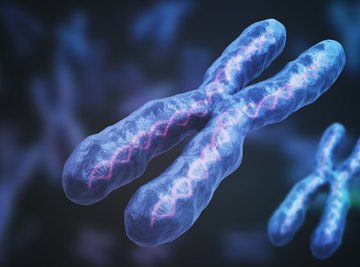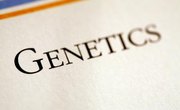
It is natural to wonder what makes male and female animals – including humans – different from each other. If you look at different species, in the cases of more complex animals such as mammals, you can usually note some clear physical differences, many of which determine the different roles males and females play in a species, particularly in the area of reproduction. But, why, fundamentally, does this occur? Why do animals even have two sexes (that is, exhibit sexual dimorphism) at all?
Organisms reproduce sexually because it allows for greater biological diversity, which is the whole point of evolution. But at the molecular level, what determined whether you are biologically female or biologically male is a matter of single tiny elements in each of your cells called sex chromosomes. Every human who has undergone typical embryonic development has 23 pairs of chromosomes, including a pair of sex chromosomes; every pair of sex chromosomes consists of either two X chromosomes or one X and one Y chromosome. But what are "chromosomes" anyway?
DNA: The Stuff of Chromosomes
Before taking a closer look at chromosomes, it's helpful to review the basis for why they exist in the first place – deoxyribonucleic acid, or DNA.
DNA is widely understood as a "genetic fingerprint" even among people without formal biology background; if you regularly watch any police-procedural dramas or follow real-life criminal trials, it's almost certain that you've seen DNA introduced as evidence to rule in or rule out a particular individual's involvement. This is because everyone's DNA is unique (members of identical twin, triplet, etc. sets excluded). DNA is no mere incidental label, however; it is literally the blueprint for the entire organism in which it resides.
DNA, in life, rather famously assumes the shape of a double-stranded helix, or corkscrew-shaped entity. It is a polymer, meaning that it consists of distinct monomeric units, which in DNA are called nucleotides. Each nucleotide contains a five-carbon sugar, a phosphate group and a nitrogenous base consisting of either adenine (A), cytosine (C), guanine (G) or thymine (T). In the double DNA strand, A bonds across the center of the helix with and only with T, and C pairs with and only with G. Each "string" of three bases in the nucelotides that make up DNA strands carries the code for specific amino acids synthesized elsewhere in the cell; these amino acids in turn are the monomeric units of proteins. Ultimately, then, DNA contains information in the form of genes, and this is expressed as each gene "coding" for a specific protein.
Chromosomes: An Overview
Chromosomes are nothing more than long strands of chromatin, and chromatin in turn is simply DNA bound to specialized packaging proteins called histones. While DNA is already coiled to some degree, these histones allow DNA to be folded and compressed into a space that consumes only a tiny fraction of the volume it would occupy if the DNA were stretched end to end. This allows an entire copy of your DNA, which in linear form would be about 2 meters long, to sit in the nuclei of your body's cells, which are about a millionth of a meter across.
Chromosomes are distinct chunks of chromatin. In humans, there are 46 chromosomes consisting of 23 pairs, with one chromosome in each pair coming from the father and one from the mother. Together, these carry the code for every protein your body is capable of making. 44 of of these 46 chromosomes are called autosomes or somatic chromosomes and are numbered 1 through 22. You therefore have one copy of chromosome 7 from your mother and another copy of chromosome 7 from your father; these look very similar to each other on a cursory look, but their base sequences are very different.
The remaining two chromosomes, called the sex chromosomes, are the X chromosome and the Y chromosome. Females have two X chromosomes, while males have one of each type. They are so named because of their rough resemblance to the letters in question on microscopy.
Chromosomes replicate, or make copies of themselves, when cells are not dividing, a part of the cell cycle called interphase. When cells divide, one of the identical copies of each chromosome (called a chromatid) winds up in each daughter cell. This process of nuclear division in cells is called mitosis.
The Human X and Y Chromosomes
Both X and Y chromosomes have genes that are unrelated to their function as sex chromosomes, and they are found on the ends of these chromosomes in areas called pseudoautosomal regions. Many of these genes are necessary for normal development to occur and do not contribute in any way to sex determination; they are simply stowaways of sorts along for the genetic ride.
The X chromosome contains about 155 million bases (actually, base pairs, but since only one strand in each pair is used for transcribing gene information, the statements are functionally equivalent. It accounts for about 5 percent of the human genome. This makes the X chromosome just sightly larger than average, given that, because there are 23 chromosomes, an average chromosome should have 1/23 of the chromatin in the body, about 4.3 percent.
In females-to-be, early in fetal development, one of the X chromosomes undergoes inactivation, meaning that its genetic code is not used for making proteins. This means that in both male and females, exactly one X chromosome is genetically active.
The Y chromosome is shorter and smaller overall than the X chromosome. It contains 59 million base pairs and accounts for about 2 percent of the DNA in the human body. It is therefore only about 40 percent of the mass of the X chromosome.
Y chromosomes are sometimes called "male chromosomes" because it is the only chromosome not found in biological females; there is no corresponding "female chromosome," because all genetically typical humans have at least one X chromosome.
Genetic Disorders Involving the X Chromosome
In 46,XX testicular disorder, people are morphologically male in spite of having two X chromosomes. This is because one of the X chromosomes contains material that is normally found on the Y chromosome and is responsible for masculinizing traits.
In Klinefelter syndrome, or 47,XXY, three sex chromosomes are present for a total of 47, with the "extra" chromosome being an X. Affected individuals are thus XXY in genotype. Sometimes, the additional X chromosome appears only in certain cells, while the remaining cells contain the normal male combination of X and Y. People with Klinefelter's syndrome experience altered patterns of sexual development both at puberty and at other times.
Genetic Disorders Involving the Y Chromosome
In a condition called 47,XYY, males have an extra Y chromosome. This condition is similar to Klinefelter's syndrome in that affected persons are males who contain an extra sex chromosome, but in this case the rogue chromosome is a Y. Males with this genetic makeup tend to be tall in stature and disproportionately suffer from learning disabilities.
In 48,XXYY syndrome, affected persons are again males, this time with two copies of each sex chromosomes. In these individuals, testes are smaller than normal, and these males are infertile (that is, they are incapable of fathering offspring). As of 2018, it was not yet known exactly what genes were to blame for these health issues.
References
About the Author
Kevin Beck holds a bachelor's degree in physics with minors in math and chemistry from the University of Vermont. Formerly with ScienceBlogs.com and the editor of "Run Strong," he has written for Runner's World, Men's Fitness, Competitor, and a variety of other publications. More about Kevin and links to his professional work can be found at www.kemibe.com.
